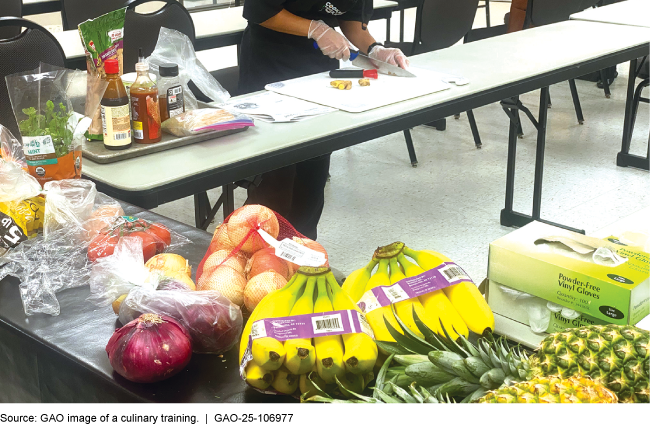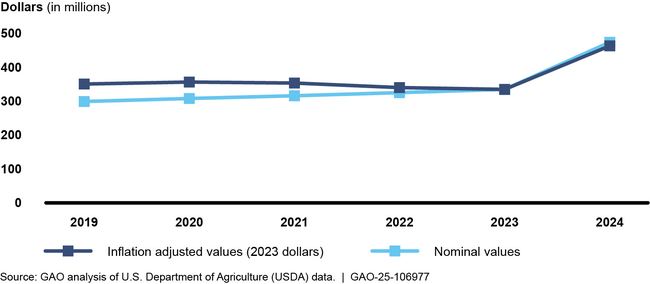Child Nutrition Programs: USDA Could Enhance Its Management and Oversight of State Administrative Expense Funds
Fast Facts
States receive federal funding from the U.S. Department of Agriculture to help administer school meals and other child nutrition programs. These funds can pay for staff salaries, trainings, and other expenses of overseeing and supporting participating schools.
However, we found some states faced challenges in using these funds. The amount states receive is set by law and doesn't fully account for certain factors that affect costs. For example, rural states may need to spend more on travel for required oversight—but may not get more funds for it.
We recommended USDA identify ways to improve how these funds are allocated, among other things.
Training Program for Local Nutrition Staff Paid with Federal Administrative Funding

Highlights
What GAO Found
Each year, in accordance with a funding formula established in federal law, the U.S. Department of Agriculture (USDA) allocates State Administrative Expense (SAE) funds to states to support their administration of child nutrition programs, including the school meal programs. States primarily spend SAE funds on salaries of staff administering these programs and other expenses. SAE funding was generally stable during the period GAO analyzed, before increasing in fiscal year 2024. That increase was due to schools serving more meals and receiving a higher rate for meal reimbursements in fiscal year 2022, according to USDA. The number and rate of reimbursement for meals served in certain child nutrition programs from 2 years earlier are key inputs in the funding formula.
Total Initial State Administrative Expense Allocations from USDA, Fiscal Years 2019–2024

All four selected states identified challenges related to the SAE funding formula and managing spending restrictions, among others. Officials from all selected states said the SAE funding formula does not fully account for factors that may increase administrative costs, such as state demographics. For example, states with rural districts may need to spend more on travel and logistics to conduct required oversight. States also face challenges effectively spending SAE funds due to uncertainty regarding the total amount they will receive over the year and the short window to spend additional funds, according to officials from all selected states and three USDA regional offices. USDA has taken some steps to give states more flexibility and resources but has not fully addressed several of the identified challenges. By identifying changes that would help improve SAE allocations and processes, including regulatory or statutory options, USDA could better assist states in using SAE funds to administer child nutrition programs.
USDA monitors states' use of SAE funds and compliance with grant requirements, but its oversight has gaps. For example, its main SAE instruction manual was last updated in 1988 and includes references to outdated policies and procedures. USDA officials said they have not updated the guidance because of several competing priorities, such as implementing a new federal program during the pandemic. Without updated SAE guidance, USDA may miss opportunities to assist states and ensure compliance with grant requirements.
Why GAO Did This Study
USDA's child nutrition programs serve billion of meals annually to help ensure that children in low-income families have access to nutritious foods at schools and other settings. SAE funds are states' primary source of federal funds to support administrative costs for five child nutrition programs. Congress appropriated about $492 million to USDA for SAE in fiscal year 2024. States must contribute a minimum amount to SAE funding each year, which totals to about $9 million.
GAO was asked to review issues related to the use of SAE funds for child nutrition programs. This report examines (1) recent trends in SAE funds states received and how they used the funds, (2) challenges selected states faced in using the funds and USDA's efforts to address the challenges, and (3) the extent to which USDA monitors states' use of the funds to achieve agency goals.
GAO analyzed data on SAE funding amounts from fiscal years 2019 through 2024. GAO interviewed officials from a non-generalizable sample of four states and conducted site visits to two of them. States were selected for variation in geographic location and SAE funding amounts, among other things. GAO also interviewed USDA officials and four nonprofit organizations that work on child nutrition issues.
Recommendations
GAO is making four recommendations to USDA, including to identify changes that would help improve SAE allocations and processes, and to update its guidance on SAE requirements. USDA generally concurred with the recommendations.
Recommendations for Executive Action
| Agency Affected | Recommendation | Status |
|---|---|---|
| Department of Agriculture | The Secretary of Agriculture should direct the Food and Nutrition Service to identify changes that would help improve SAE allocations and processes and determine how it could implement those changes, including by pursuing any regulatory changes or requesting any necessary statutory authority. (Recommendation 1) |
USDA agreed with this recommendation, noting that it aligns with the agency's guiding principles and priorities of executing programs with integrity and accountability. USDA stated that efforts are already underway to address it, including reviewing and taking actions consistent with the 2020 study the agency commissioned to assess the SAE funding formula and present a series of options to potentially improve SAE allocations and procedures. We await further progress on this recommendation.
|
| Department of Agriculture | The Secretary of Agriculture should direct the Food and Nutrition Service to identify specific steps it can take to help ensure the agency has current information on states' planned budgets and activities for using SAE funds, such as better communicating expectations for submission of SAE plans or working with Congress to consider whether the frequency with which these are submitted needs to be revised. (Recommendation 2) |
USDA agreed with this recommendation, noting that it aligns with the agency's guiding principles and priorities of executing programs with integrity and accountability. USDA plans to provide more detailed responses on its actions within 180 days. We await further information and progress on this recommendation.
|
| Department of Agriculture | The Secretary of Agriculture should ensure the Food and Nutrition Service establishes timeliness goals or other targets to ensure states take corrective action on SAE compliance review findings in a timely manner. (Recommendation 3) |
USDA agreed with this recommendation, noting that it aligns with the agency's guiding principles and priorities of executing programs with integrity and accountability. USDA plans to provide more detailed responses on its actions within 180 days. We await further information and progress on this recommendation.
|
| Department of Agriculture | The Secretary of Agriculture should ensure the Food and Nutrition Service updates its SAE guidance to reflect current SAE grant requirements and is useful to state agency personnel responsible for compliance. (Recommendation 4) |
USDA agreed with this recommendation, noting that it aligns with the agency's guiding principles and priorities of executing programs with integrity and accountability. USDA plans to provide more detailed responses on its actions within 180 days. We await further information and progress on this recommendation.
|
